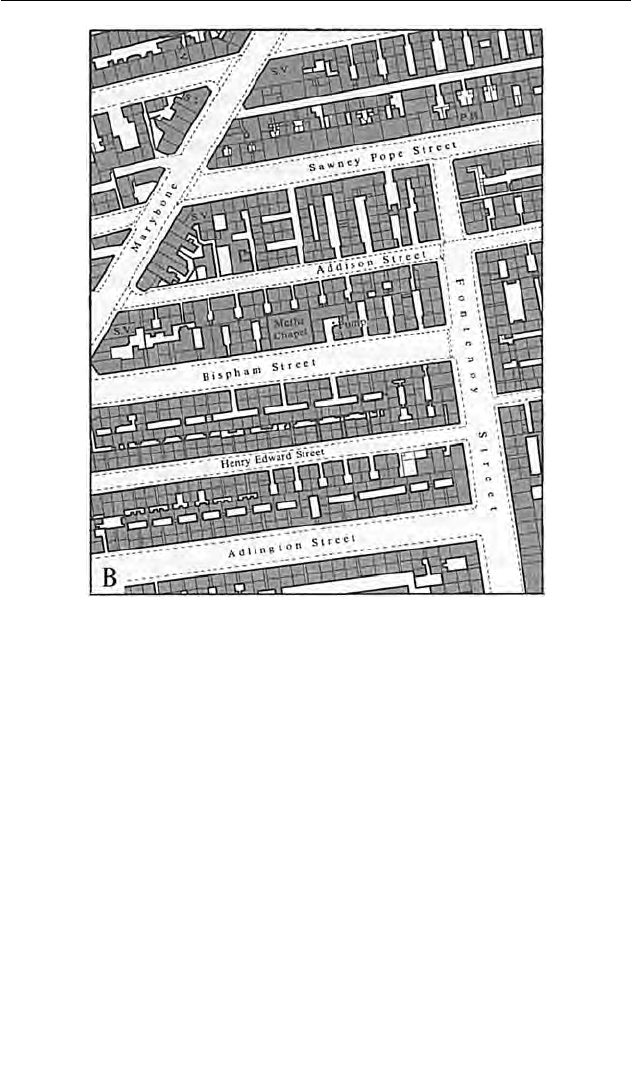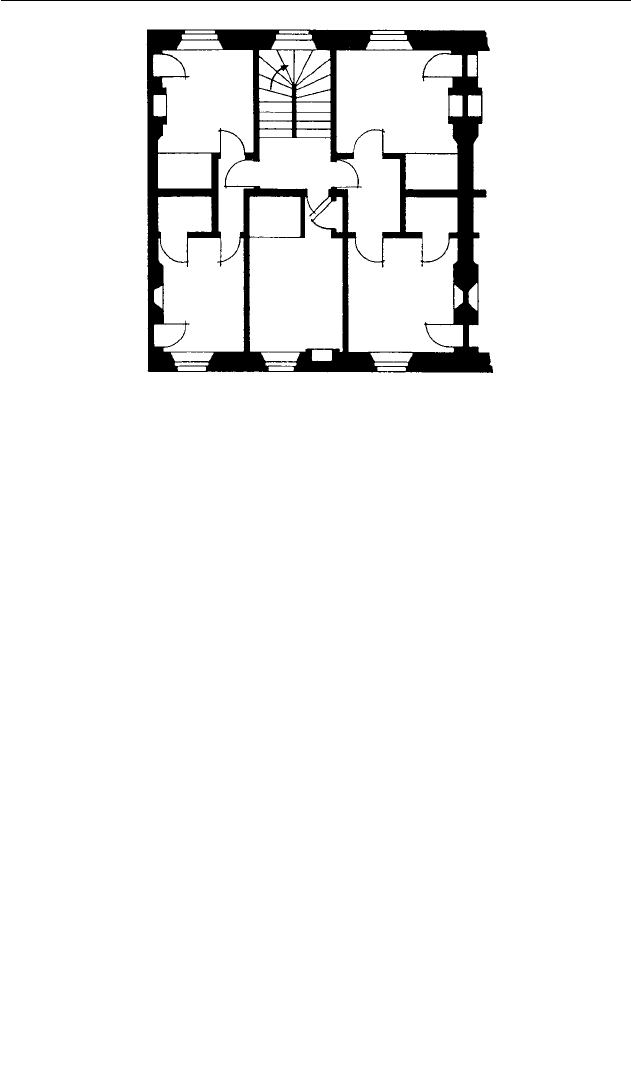Daunton M. The Cambridge Urban History of Britain, Volume 3: 1840-1950
Подождите немного. Документ загружается.


mobility has increased and time-space compression has taken place. Not only can
people travel further, more quickly and easily, but increasingly they are able to
control the environment in which they travel. In terms of place identity there is
a world of difference between travelling on public transport and travelling by car.
Until at least the s most people travelled to work, school or recreation on
foot or by public transport. They thus occupied public spaces and could have
easily developed a strong sense of place identity for the localities through which
they passed. Greater use of the private car from the mid-twentieth century has
meant that people have been increasingly cut off from places through which they
pass. Inside the car it is possible to create an artificial personal environment
devoid of any affiliation with the surrounding townscape. With more home-
based activities, and less need to interact with neighbours and surroundings, it
can be suggested that people have created their own artificial ‘habitus’, distinct
from the local community and almost devoid of place identity. As most people
spend a large part of their lives in and around the home, and residential devel-
opment has had a major impact on British urban areas, the following sections
focus particularly on housing market changes since the s, and examine the
relationship between the provision of housing, access to housing and the use
made of residential space.
(iv)
The private housing market underwent fundamental change in the century after
, producing alterations in housing tenure, quality, access and form. These
features both reflected broader changes in the nature of society and economy
and, in turn, created new ideals and aspirations which had wide-ranging
implications.
In the nineteenth century most urban residents rented a house or rooms from
a private landlord. Only the very rich could afford to purchase a house outright,
and a small but increasing number of skilled working-class and middle-class
households built and purchased their housing through the use of terminating
building societies. By the late nineteenth century home ownership had attained
levels of – per cent in more affluent industrial areas with stable employment
(especially South Wales, east Lancashire, West Yorkshire and North-East
England), but nationally no more than per cent of households were owner-
occupiers. Most families rented their housing and most landlords owned relatively
small numbers of properties. The twentieth century saw a fundamental change
in the tenure structure of cities as the ideology of home ownership became dom-
inant and renting from a private landlord became an increasingly marginalised
tenure used only by those on low incomes or seeking temporary accommoda-
tion. By , per cent of households in Britain were owner-occupiers (Table
Colin G. Pooley
Cambridge Histories Online © Cambridge University Press, 2008

.) and the substantial but declining numbers of households in privately rented
housing were significantly disadvantaged. In Scotland rates of owner-occupancy
were lower, but the same trends are observable.
52
Six main factors explain the rise of home ownership and the decline of private
renting in the twentieth century.
53
First, rising real incomes gave families a wider
choice and made it possible for at least some working-class households to
commit themselves to mortgage repayments. Second, a decline in the cost of
ownership made renting less attractive as house construction costs fell and loan
interest rates remained low. Third, building societies were becoming larger and
adopted a deliberate policy of lending to individuals who were purchasing for
owner-occupancy as opposed to lending mainly to landlords who purchased
several houses, as had been the case in the nineteenth century. Fourth, changing
aspirations within society created an environment in which families perceived
home ownership to be preferable to renting. Fifth, landlords increasingly saw
Patterns on the ground
52
J. Burnett, A Social History of Housing, –, nd edn (London, ); E. Gauldie, Cruel
Habitations (London, ); S. D. Chapman, ed., The History of Working-Class Housing (Newton
Abbot, ); P. H. J. H. Gosden, Self Help (London, ); S. Price, Building Societies (London,
); E. J. Cleary, The Building Society Movement (London, ); M. Boddy, The Building Societies
(London, ); J. Springett, ‘Building development on the Ramsden estate, Huddersfield’,
Journal of Historical Geography, (), –; Daunton, House and Home; H. J. Dyos, Victorian
Suburb (Leicester, ); P. Aspinall, ‘The internal structure of the housebuilding industry in
nineteenth-century cities’, in Johnson and Pooley, eds., The Structure, pp. –; M. Doughty,
ed., Building the Industrial City (Leicester, ); R. Rodger, ed., Scottish Housing in the Twentieth
Century (Leicester, ).
53
See C. Pooley, ed., Housing Strategies in Europe (Leicester, ), pp. –; M. J. Daunton, A
Property-Owning Democracy? (London, ); S. Merrett, Owner-Occupation in Britain (London,
).
Table . Housing tenure in Britain, – (%)
Owner- Public Private Other
Year occupied rented rented tenures
a
....
....
....
....
All figures before are estimates.
a
Includes housing occupied by virtue of employment and rented from Housing
Associations.
Sources: various, including M. Boddy, The Building Societies (London, ), p. ;
Census of England and Wales and Census of Scotland, . See also C. Pooley, ed.,
Housing strategies in Europe (Leicester, ), p. .
Cambridge Histories Online © Cambridge University Press, 2008

renting as a poor investment as the political influence they had in the nineteenth
century was eroded by extension of the franchise, and the imposition of rent
controls in at least temporarily restricted landlords’ incomes. Sixth, the
activities of local authorities in slum clearance physically removed substantial
numbers of rented houses in the twentieth century, whilst private rebuilding was
almost entirely for owner-occupancy.
For individual families access to owner-occupied housing could be achieved
through two separate routes. In the early s, when there was relatively little
new building in the private sector, many families who aspired to home owner-
ship simply bought the house which they had previously rented (from to
over million rented houses were sold to owner-occupiers), but from the
mid-s when private house construction expanded, the main route to home
ownership was by purchasing a new house in the suburbs. This process was par-
ticularly marked in the more prosperous towns of southern and Midland
England. In northern cities hit by recession in the interwar period the expan-
sion of home ownership was rather slower. Whichever route was taken, owner-
occupancy usually provided better quality housing than was available in the
privately rented sector. Existing property bought by sitting tenants consisted
mostly of newer and larger rented housing in the inner suburbs, whilst newly
built housing was almost always semi-detached and suburban. These new private
estates had a considerable impact on the form of most towns as low-density
development often extended beyond existing city limits whilst slum clearance
sites in town centres could remain undeveloped for several years due to lack of
interest by builders and developers who preferred to build in more lucrative sub-
urban locations. In Scotland, traditional tenement building styles continued to
be important, and a substantial proportion of new developments in cities like
Glasgow and Edinburgh were in the form of suburban tenements for skilled
working-class and middle-class families.
54
Although owner-occupancy expanded rapidly in the twentieth century, and
ideologically it became the dominant tenure, access to home ownership was not
available to all. The main source of finance for house purchase was a loan from
a building society. Although such societies had declared aims of helping ordi-
nary working people to improve their housing, and were driven by large capital
reserves and low interest rates to expand the range of clients to whom they lent,
home ownership was restricted to those on regular incomes who could afford to
move to suburban locations some distance from their place of work. Thus loans
made by the Manchester and Hull branches of the Bradford Building Society
in the s were predominantly to those in trade, clerical work and public or
professional employment. Some skilled workers in manufacturing industry
Colin G. Pooley
54
C. G. Pooley and M. Harmer, Property Ownership in Britain, ‒ (Cambridge, ); M.
Yeadall, ‘Building Societies in the West Riding of Yorkshire and their Contribution to Housing
Provision in the Nineteenth Century’, in Doughty, ed., Building the Industrial City; Rodger, ed.,
Scottish Housing.
Cambridge Histories Online © Cambridge University Press, 2008

gained mortgages but very few with unskilled or semi-skilled occupations.
55
The
benefits of expanding home ownership were not shared equally in the twenti-
eth century.
The impact of these changes in the housing market on people’s lives and the
ways in which residential space was used in urban areas can be illustrated through
a series of case studies of specific types of housing. This will take the form of a
life cycle analysis, showing how changes in society and economy interacted with
the everyday decisions of urban dwellers to structure the ways in which proper-
ties were habited during the life of particular types of housing. Four housing
forms are chosen for analysis: small terrace housing built in the s, an inner-
city tenement block built in the s, better quality terrace housing built in the
first decade of the twentieth century, and suburban semi-detached housing built
in the early s.
Almost every town in England and Wales experienced rapid population
growth in the early nineteenth century. Whilst some of this population crowded
into rooms in existing properties which filtered down from the departing middle
classes, there was also an expansion of new purpose-built terrace housing.
Typically constructed in narrow streets close to areas of industrial employment,
in northern towns in particular such housing could also be of very high density
laid out in courts, sometimes back-to-back and often with a separately habited
cellar. In Liverpool in such housing in a dockside area of Scotland ward
was occupied by mainly unskilled and semi-skilled families,
56
many of whom
lived in only one or two rooms with communal water, cooking and sanitary
facilities (Figure .). Space was acutely restricted in such housing and many
members of the family were forced to live much of their lives in the yard or on
the street. Limited residential space meant that public areas including common
stairs, yards and back streets effectively became an extension of private space,
with consequent implications both for community solidarity and neighbour-
hood squabbles. The implications of high-density living for social order were
highlighted by the chief constable of Liverpool in who, commenting on a
decline in violent brawls, stated: ‘To the demolition of the old back to back
courts may be ascribed no small part of the improvement in this matter. The
enclosed courts gave two quarrelsome people no chance of getting away from
each other, but only gave them a fighting ground out of sight of the constable
on the beat.’
57
Whilst most men were out of the house at work for long periods,
the restricted living space would have been felt especially acutely by women and
children. Conditions and contemporary attitudes (in the s) are summed up
by the comments of journalist Hugh Shimmin on a court in Thomas Street:
Patterns on the ground
55
Pooley and Harmer, Property Ownership.
56
I. Taylor, ‘The court and cellar dwelling: the eighteenth-century origin of the Liverpool slum’,
Transactions of the Historical Society of Lancashire and Cheshire, (), –; Pooley, ‘Choice
and constraint’.
57
L. Dunning, Report on the Police Establishment and the State of Crime (Liverpool, ), p. .
Cambridge Histories Online © Cambridge University Press, 2008

In the back part of this house . . . there is a dwelling worthy of particular atten-
tion. It is the home of a father, mother and five children. The rooms they occupy
are immediately over a stable and midden, and the privy, which is used in common,
is under the stairs. The entrance of the house is up a dark, crooked flight of stairs.
You cannot walk straight going up, the ceiling is so low, and, when you gain the
first landing the stench from below is stifling . . . The husband is in constant
employment, and was said to be very steady, but how he could reconcile himself
to look daily upon the amicable union of filth and laziness which his house exhib-
ited was a puzzle. The convenience of this home to his labour was given as the
reason for remaining in such a doghole . . . The woman was sallow, but lively, and,
although her children had weak eyes and a sickly look, were streaked with dirt,
and gnawed at junks of bread whilst staring at us, the mother said they never
seemed to ail much.
58
Colin G. Pooley
58
H. Shimmin, The Courts and Alleys of Liverpool (Liverpool, ), pp. –.
Figure . Back-to-back and court housing in Liverpool, built ‒ ()
Source: J. A. Patmore and A. Hodgkiss, eds., Merseyside in Maps
(London, ), p. .
Cambridge Histories Online © Cambridge University Press, 2008

By the s such housing was still occupied by poor families, though at slightly
lower densities as voluntary out-migration and limited public health interven-
tions removed some people from inner-city areas. Such housing was increasingly
perceived as a public health problem as city authorities adopted a more interven-
tionist approach to slum housing.
59
Although housing conditions were poor for the families that lived in such dis-
tricts, there would have been a strong sense of community and employment ties
meant that many families that might have afforded better housing were unable
to move away. Although in some towns early nineteenth-century housing was
demolished in the s, more typically such property survived until large-scale
slum clearance schemes of the s. Living conditions were often little better
than the mid-nineteenth century, as recalled by a respondent eventually rehoused
in the s:
We lived with my mother when we were first married. It was a little two-bed-
roomed terraced house and there was my mother, aunt and cousin in one bedroom
and me, my husband and the baby in the other. It was an old house, very cold and
damp and it didn’t have any conveniences at all. No water at all in the house. I
don’t know how we did it, but we had to do the washing outside.
60
In Liverpool and other cities, a series of inner-area clearance schemes swept away
slum housing and, although most families were rehoused in new corporation
housing on or near the same site, traditional communities were often destroyed.
Although the new schemes were welcomed by some, the disruption to estab-
lished patterns of life was felt acutely by many of those dispossessed from the
slums. For financial and other reasons some families chose to move into poor-
quality privately rented housing elsewhere rather than live in new corporation
housing schemes (see below). As one disillusioned tenant stated: ‘The Corpora-
tion thought they were giving the likes of us the world, getting us out of the
slums, but they didn’t care that none of us could afford the bloody houses. They
dumped us out here and then forgot about us.’
61
In a Scottish city such as Glasgow similar processes were evident, but the
housing form was different and, if anything, both housing conditions and
poverty were worse than in English towns. All towns in Britain experienced an
expansion of new private building in the s. Whilst in England and Wales
this mostly took the form of terrace housing, in Glasgow tenement blocks close
to the city centre were the norm (Figure .). In the s a typical Glasgow
tenement was occupied at very high density by a mixture of skilled and unskilled
Patterns on the ground
59
Yelling, Slums and Redevelopment; P. J. Waller, Democracy and Sectarianism (Liverpool, ).
60
M. McKenna, ‘The suburbanisation of the working-class population of Liverpool between the
wars’, Soc. Hist., (), .
61
Ibid., . See also D. C. Jones, ed., Merseyside (Liverpool, ); C. G. Pooley and S. Irish, ‘Access
to housing on Merseyside’, Transactions of the Institute of British Geographers, new series, (),
–.
Cambridge Histories Online © Cambridge University Press, 2008

working-class families. The main difference from England was the very high
level of occupancy, albeit in rather larger rooms. Perhaps eight people would
share one or two rooms for eating, sleeping and everyday living with bed spaces
curtained off from the main room to provide limited privacy. Such housing con-
ditions fundamentally affected social interaction and use of space. Privacy was
limited and many activities would take place outside the home. With such over-
crowded conditions and a lack of basic facilities cleanliness and tidiness were
difficult, and inquiries at the turn of the century demonstrated the extent to
which Scottish housing conditions affected the health of the population.
62
J. B.
Russell wrote in :
Glasgow stands alone with the highest death-rate, the highest number of persons
per room, the highest proportion of her population occupying one-apartment
houses, and the lowest occupying houses of five apartments and upwards . . . These
facts prove beyond a doubt that the predominant factor in the health of cities is
the proportion of house space to inhabitant . . . It is those small houses which give
. . . the striking characteristics of an enormous proportion of deaths in childhood,
and of deaths from diseases of the lungs at all ages. Their exhausted air and poor
and perverse feeding fill our Streets with bandy-legged children.
63
Colin G. Pooley
62
Rodger, Scottish Housing; A. Gibb, Glasgow (London, ); R. A. Cage, ed., The Working Class
in Glasgow, – (London, ), esp. chs. and ; A. K. Chalmers, The Health of Glasgow,
–: An Outline (Glasgow, ); A. MacGregor, Public Health of Glasgow, –
(Edinburgh, ).
63
Quoted in Gibb, Glasgow, p. .
Figure . Floor plan of a typical late nineteenth-century working-class
tenement in Glasgow (internal stair, no internal sanitation)
Source: R. Rodger, ‘Scotland’, in C. Pooley, ed., Housing Strategies in Europe
– (Leicester, ).
kitchen
bed
bed
bed
bed
bed
room
room
room
single
lobby
landing
kitchen
Cambridge Histories Online © Cambridge University Press, 2008

By the first decade of the twentieth century housing conditions in Glasgow
tenements had become a major local political and social issue, with rent strikes
by tenants and local women protesting vigorously about the conditions in which
they had to spend most of their lives. However, things changed only slowly.
Although there was some slum clearance in the s, by the s many such
tenements were still standing, usually occupied by an increasingly marginalised
population of transients, the very poor and young single people (including stu-
dents) seeking temporary accommodation.
64
At the end of the nineteenth century many towns expanded with rows of
brick-built terrace housing providing much better accommodation than their
mid-nineteenth-century counterparts. Providing increased space, privacy and
sanitary amenities such houses were almost exclusively in single-family occu-
pancy and attracted mainly skilled working-class and lower-middle-class house-
holds. Particularly in the more prosperous economies of southern towns such as
Reading, Hastings or Bristol such properties were typically bought by sitting
tenants in the s. Clearly these were households that were satisfied with their
housing conditions, they had sufficient space and facilities to maintain their
desired life style, and they chose to take advantage of the attractions of home
ownership with the minimum disruption to their everyday life.
65
However, by
the s such properties had become less attractive. Areas that had been outer
suburbs in were now close to decaying inner-city districts, and many fam-
ilies left for better quality suburban housing. Those left behind were often the
elderly and the very poor whilst low-income families, transient populations and
recent immigrants (especially from New Commonwealth countries) took the
place of those leaving. The nature of the community fundamentally changed and
many families were alienated from an environment in which they had grown up.
In the s such property was either demolished to make way for new housing
schemes or, if it survived, rehabilitated under inner-city improvement schemes
of the s.
Upwardly mobile families who, in the s, frequently moved into new, low-
density, suburban owner-occupied housing were also drawn predominantly from
skilled manual and non-manual households (Table .). For some this was their
first experience of home ownership, but others moved from owner-occupied
terrace housing they had bought earlier in the century. Cardiff is typical of a
medium-sized town which developed substantial peripheral estates of privately
owned housing in areas such as Whitchurch and Llandaff from the late s.
Families moving into such housing were almost always skilled workers, who
Patterns on the ground
64
J. Melling, Rent Strikes (Edinburgh, ); U. Wannop, ‘Glasgow/Clydeside: a century of met-
ropolitan evolution’, in Gordon, ed., Regional Cities, pp. –; S. Checkland, The Upas Tree
(Glasgow, ).
65
M. Swenarton and S. Taylor, ‘The scale and nature of the growth of owner-occupation in Britain
between the wars’, Ec.HR, nd series, (), –; Pooley and Irish, ‘Access to housing’.
Cambridge Histories Online © Cambridge University Press, 2008

gained a mortgage of around £ to enable them to purchase the property.
Whilst such housing provided both good-quality accommodation and ample
space for daily life, it could also lead to isolation on new estates as those moving
in had few friends and were distant from places of work and recreation. The
space afforded by new suburban housing allowed a more home-based life style,
but to some extent this was also forced on families by the lack of alternatives
within the new communities. Arguably this problem was much graver in large
cities, where distances were greater, than in small towns where it was easy to
travel from the suburbs to the city centre.
The links between housing change, the built form of cities, the use of space
and broader societal processes are complex. Whilst predominance of the privat-
ised nuclear family was in part produced by changes in levels of fertility, family
aspirations, employment opportunities, mobility and the availability of home-
based entertainment, it can be argued that the development of specific housing
forms not only accommodated such changes but also encouraged them. A house
which provided separate rooms for each child, in which functions of eating,
sleeping and socialising were separated into distinct spaces, and in which fami-
lies were cut off from neighbours by gardens and private drives encouraged
people to become more inward looking and less involved with the local com-
munity. The dominant ethos of owner-occupancy also encouraged increased
pride in the home, leading to more time spent on home improvements, deco-
rating, gardening and other home-based activities.
The rise of owner-occupancy is also linked to the type of liberal democratic
capitalist society that has developed in Britain in the twentieth century. All polit-
ical parties have to some degree maintained a commitment to owner-occupancy
Colin G. Pooley
Table . Socio-economic group of mortgage clients in three northern towns in the
s (%)
Hull Bradford Manchester
Socio-economic group – –
Professional ...
Intermediate/managerial ...
Skilled non-manual ...
Skilled manual ...
Semi-skilled ...
Unskilled ...
Total with occupation
Sources: mortgage ledgers of Bradford Equitable Building Society and directories of
Hull, Bradford and Manchester.
Cambridge Histories Online © Cambridge University Press, 2008

since the s, with widespread ownership seen, especially in the interwar
period, as a way not only of distributing wealth more evenly but also of ensur-
ing mass commitment to a capitalist society. Although home ownership has
brought benefits to many in terms of improved housing, it has not been without
drawbacks. Due to the dependence on large mortgage debts, ownership of prop-
erty has not necessarily brought with it power and control over residential space.
During the interwar recession mortgage debt became an impossible burden for
some, who were forced back into the declining privately rented sector, whilst
others who bought older inner-city property have seen their neighbourhood
change around them in a way which they could not influence. For some the
attractions of owner-occupancy turned sour, a trend which has continued into
the s and s as negative equity caused by falling property prices has
trapped many families in houses they wish to leave.
66
For such home owners the
flexibility of the nineteenth-century rented property market could hold some
attractions.
(v)
Whilst the private housing market was transformed from the s to the s
from renting to ownership, the public housing market grew from nothing to
account for almost one third of the housing stock of Great Britain. Public
housing was especially important in Scotland and in most large urban areas: by
the s renting from the local authority was the single most important tenure
in some British cities. Although the framework for public intervention in
housing has been established through national legislation, before the First World
War local by-laws and interpretation of national legislation were of most impor-
tance. Even in the twentieth century there were significant variations between
places in the ways in which local authority housing was provided.
67
In the mid-nineteenth century public intervention in housing was both
limited and, for most people, politically unacceptable. Until the s state inter-
vention consisted of control and regulation of private property through limited
building regulations, controls on occupancy levels, or slum clearance of severely
sub-standard dwellings. All rebuilding was left to the private sector. The first
council housing built for families (as opposed to corporation-built lodging
houses) was begun under local legislation in Liverpool in the s and
Patterns on the ground
66
Daunton, Property-Owning Democracy?; R. Forrest, A. Murie and P. Williams, Home Ownership
(London, ); P. Saunders, A Nation of Home Owners (London, ); V. Karn, J. Kemeny and
P. Williams, Home Ownership in the Inner City (Aldershot, ); R. Forrest and A. Murie, ‘Home
ownership in recession’, Housing Studies, (), –.
67
S. Merrett, State Housing in Britain (London, ); D. Niven, The Development of Housing in
Scotland (London, ); Rodger, Scottish Housing.
Cambridge Histories Online © Cambridge University Press, 2008
